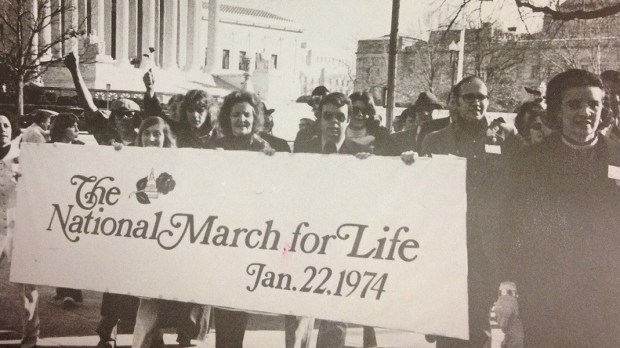The 46th March for Life is set to kick off this Friday, as hundreds of thousands of marchers descend upon Washington, D.C. to march in demonstration of their commitment to the ideals of the pro-life movement. The four-day affair is expected to be the highest attended to date, in what has become the largest pro-life demonstration in the world.
What the eager masses en route to the nation’s capital might not realize, however, is that the very first March for Life, which was organized back in 1974 — on the first anniversary of the passing of the controversial Roe v. Wade decision — almost never took place. The project may never have gotten off the ground without the dedication and know-how of Nellie Gray.
Aleteia’s own John Burger, writing for the Knights of Columbus, explains that the annual protest began as the brainchild of a few Knights of Columbus and their wives who sought to commemorate the tragic day that abortion was made legal in the U.S. When the organizers first came together, however, the general feeling was that if the event was poorly run, then it could have a negative effect on the movement.
It was then that they were put in contact with Nellie Gray, a Catholic attorney who had retired from a career with the U.S. Department of Labor. Gray agreed to hold a meeting at her home, where the group shared a meal and got down to business. Gray asked them to explain why the march should take place, at which point Eileen Vogel, of Women Concerned for the Unborn Child in Pennsylvania, told her:
“If there were only 10 of us, history would have to record that there was a voice of protest against the killing of innocent babies.”
Gray was taken by the argument and she agreed to help, at which point she was put in charge of the whole project, as she was the most familiar with navigating Washington’s political system. Gray organized the first ever March for Life for January 22, 1974, exactly one year after the passage of Roe v. Wade.
Burger notes that, while those in charge had worried that inclement weather could have stopped the effort dead in its tracks, the day turned out to be 70 degrees and sunny — unseasonable weather for the D.C. region. Those present, including Vogel, attributed the weather to “divine providence.”
The first March for Life was a resounding success, drawing in more than 20,000 people to march on D.C., with some of them coming from as far as Illinois. The event was so well received by the attendees that it would grow steadily each year. In 2019, organizers expected around 100,000 to turn out, but by the end of the March for Life reports cited the number as between 200,000 and 300,000.
The success of the American demonstration has led to supplemental events surrounding the March for Life, but it has also led to the movement spreading to the global stage. According to the March for Life website, there are annual demonstrations held in Ottawa and Victoria, Canada; Birmingham, United Kingdom; Prague; Rome; Brussels; Lima, Peru; Lisbon, Portugal; Zagreb, Croatia; in over 40 cities across Colombia; France; Mexico; and Ireland.
For more information on the maiden voyage of the March for Life, click here to read John Burger’s full, detailed article, complete with a timeline of the history of abortion in America.

